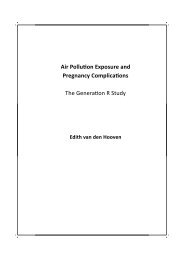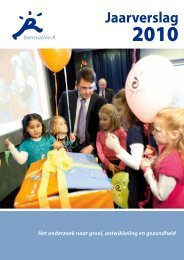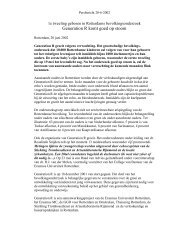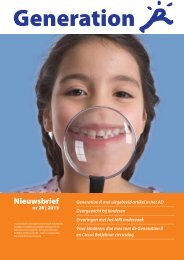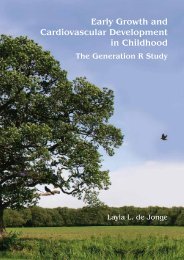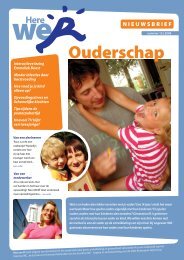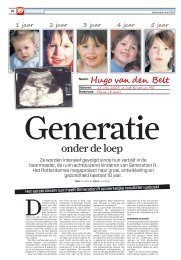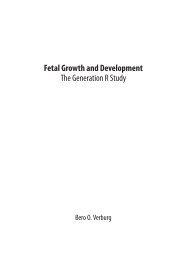Parents and infants: determinants of attachment in a ... - Generation R
Parents and infants: determinants of attachment in a ... - Generation R
Parents and infants: determinants of attachment in a ... - Generation R
Create successful ePaper yourself
Turn your PDF publications into a flip-book with our unique Google optimized e-Paper software.
Chapter 6<br />
ABSTRACT<br />
Attachment disorganization <strong>in</strong> <strong>in</strong>fancy is a risk factor for behavior problems <strong>and</strong><br />
other psychopathology. Traditionally the role <strong>of</strong> parental behavior for qualitative<br />
differences <strong>in</strong> early <strong>attachment</strong> relationships has been emphasized. However,<br />
disrupted <strong>in</strong>fant-parent <strong>in</strong>teractions only partly expla<strong>in</strong> <strong>attachment</strong> disorganization.<br />
A complementary focus on child factors such as early differences <strong>in</strong><br />
the underly<strong>in</strong>g neurobiological systems is needed. We exam<strong>in</strong>ed whether<br />
early structural differences <strong>in</strong> the gangliothalamic ovoid, compris<strong>in</strong>g <strong>of</strong> the<br />
basal ganglia <strong>and</strong> the thalamus, are <strong>in</strong>volved <strong>in</strong> the etiology <strong>of</strong> <strong>in</strong>fant <strong>attachment</strong><br />
disorganization. Gangliothalamic ovoid diameter was measured by ultrasound<br />
<strong>in</strong> 6-week-old participants <strong>of</strong> a prospective population-based cohort<br />
study. Attachment classification <strong>of</strong> 629 <strong>of</strong> these <strong><strong>in</strong>fants</strong> was assessed with the<br />
Strange Situation at 14 months <strong>of</strong> age. Neurobiological differences with<strong>in</strong> the<br />
normal range were prospectively associated with <strong>attachment</strong> disorganization.<br />
Infants with a larger gangliothalamic ovoid at 6 weeks had a lower risk <strong>of</strong> <strong>attachment</strong><br />
disorganization at 14 months (OR 0.73 per SD <strong>in</strong>crease <strong>in</strong> dia meter, 95%<br />
CI 0.57 to 0.93, p < .05). Volume <strong>of</strong> the lateral ventricles as an <strong>in</strong>dex <strong>of</strong> general<br />
bra<strong>in</strong> development was not associated with <strong>attachment</strong> disorganization. These<br />
f<strong>in</strong>d<strong>in</strong>gs provide new <strong>in</strong>sight <strong>in</strong> the etiology <strong>of</strong> <strong>in</strong>fant <strong>attachment</strong> disorganization<br />
that may <strong>in</strong> part be neurodevelopmentally determ<strong>in</strong>ed.<br />
104



